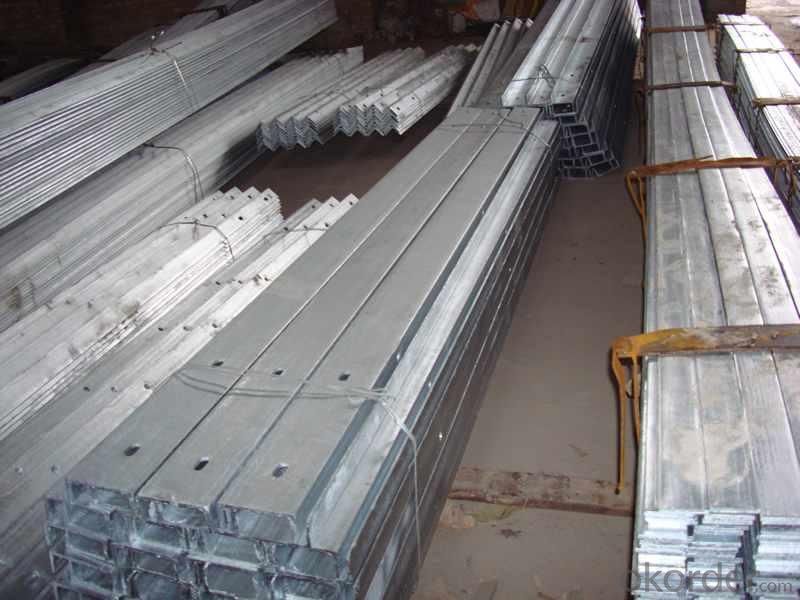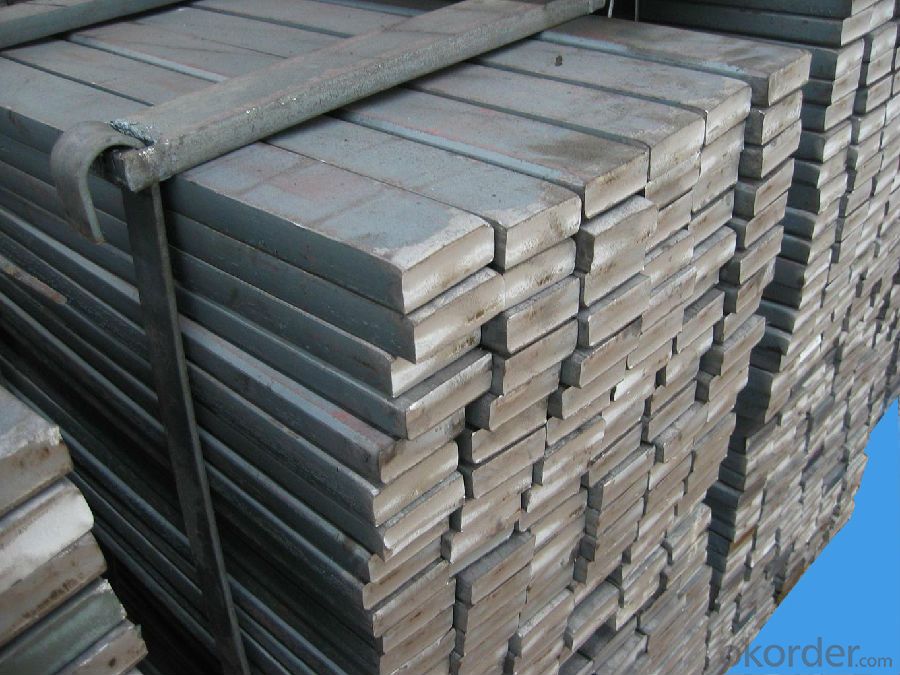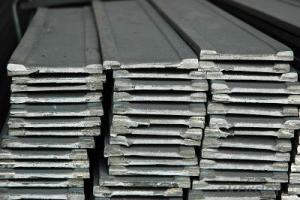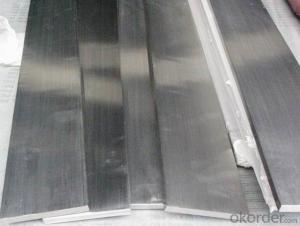JIS standard steel flat bar for construction
- Loading Port:
- Tianjin
- Payment Terms:
- TT OR LC
- Min Order Qty:
- 10000 m.t.
- Supply Capability:
- 100000 m.t./month
OKorder Service Pledge
OKorder Financial Service
You Might Also Like
Item specifice
Product Description:
OKorder is offering JIS standard steel flat bar for construction at great prices with worldwide shipping. Our supplier is a world-class manufacturer of steel, with our products utilized the world over. OKorder annually supplies products to European, North American and Asian markets. We provide quotations within 24 hours of receiving an inquiry and guarantee competitive prices.
Product Applications:
JIS standard steel flat bar for construction are ideal for structural applications and are widely used in the construction of buildings and bridges, and the manufacturing, petrochemical, and transportation industries.
Product Advantages:
OKorder's Steel flat bar are durable, strong, and resist corrosion.
Main Product Features:
· Premium quality
· Prompt delivery & seaworthy packing (30 days after receiving deposit)
· Corrosion resistance
· Can be recycled and reused
· Mill test certification
· Professional Service
· Competitive pricing
Product Specifications:
Manufacture: slited
Slitting precision (width) : 0.5 mm or less
Raw material: Q235B, Q345B, Q235-1 b
crosscutting precision (length) : 2 mm or less
Processing: the thickness of 2.0-16 mm;
Shear length: 2000 mm above
Wide degree: 15-1250 - mm;
Leveling precision: 1-2 MM square
Packaging: Export packing, nude packing, bundled



FAQ:
Q1: What makes stainless steel stainless?
A1: Stainless steel must contain at least 10.5 % chromium. It is this element that reacts with the oxygen in the air to form a complex chrome-oxide surface layer that is invisible but strong enough to prevent further oxygen from "staining" (rusting) the surface. Higher levels of chromium and the addition of other alloying elements such as nickel and molybdenum enhance this surface layer and improve the corrosion resistance of the stainless material.
Q2: Can stainless steel rust?
A2: Stainless does not "rust" as you think of regular steel rusting with a red oxide on the surface that flakes off. If you see red rust it is probably due to some iron particles that have contaminated the surface of the stainless steel and it is these iron particles that are rusting. Look at the source of the rusting and see if you can remove it from the surface.
- Q:Are steel flat bars suitable for welding or fabrication?
- Indeed, welding or fabrication can be accomplished with steel flat bars. These flat bars find widespread usage across diverse industries such as construction, manufacturing, and transportation owing to their adaptability and robustness. By welding them together, one can effortlessly construct larger frameworks or fashion them into various dimensions and configurations to fulfill specific project needs. The act of welding steel flat bars enables the formation of sturdy and long-lasting connections, rendering them suitable for applications demanding structural integrity. Furthermore, steel flat bars can be effortlessly cut, drilled, and shaped, thus making them highly favored for the fabrication of an extensive array of products.
- Q:What are the maximum temperature limits for steel flat bars?
- The maximum temperature limits for steel flat bars can vary depending on the specific grade of steel being used. However, in general, most steel flat bars can withstand temperatures up to around 1000°C (1832°F) without significant structural damage.
- Q:What is the representation of flat steel?
- In use, it has advantages over steel platesFlat steel adopts negative deviation rolling, but according to actual weight, the utilization ratio of steel plate is 1~5 percentage points higher than that of steel plate.Flat can according to user needs, set the thickness, width and length of production, for the user to reduce the cut and save processes, reducing labor, material consumption, but also reduce the loss of raw materials processing, time saving, material saving. Products have been specialized in steel structure manufacturing, machinery manufacturing, automotive industry, mining machinery, lifting machinery and other industrial materials.
- Q:Can steel flat bars be used for fencing or railing?
- Yes, steel flat bars can be used for fencing or railing. Steel flat bars are commonly used in construction applications due to their strength and durability. They are often used as pickets for fences or as balusters for railings. The flat shape of the bars allows for easy installation and creates a sleek and modern look. Additionally, steel flat bars can be easily customized to match the desired design and can be painted or coated to prevent rust and corrosion. Overall, steel flat bars are a suitable choice for fencing or railing projects due to their sturdiness and versatility.
- Q:Does the cable trench need grounding?
- The cable trench needs grounding.
- Q:What are the safety considerations when working with steel flat bars?
- When working with steel flat bars, important safety considerations include wearing appropriate personal protective equipment (PPE) such as gloves, safety glasses, and steel-toed boots to protect against potential injuries from sharp edges or falling bars. It is crucial to ensure that the work area is well-ventilated and free from any flammable materials as sparks generated during cutting or welding processes can pose fire hazards. Additionally, proper handling techniques should be followed to avoid strains or injuries, and using appropriate tools and equipment, such as clamps or vices, can help stabilize the bars and minimize the risk of accidents.
- Q:Can steel flat bars be used in marine applications?
- Yes, steel flat bars can be used in marine applications. However, it is important to use a specific type of steel known as marine-grade or stainless steel for such applications. Regular steel is susceptible to corrosion and rust when exposed to saltwater or high humidity environments, which is common in marine settings. Marine-grade steel, on the other hand, is specifically designed to withstand the harsh conditions of the marine environment. It is resistant to corrosion, rust, and pitting, making it suitable for use in marine applications such as boat building, ship construction, and offshore platforms.
- Q:Can steel flat bars be used for making hinges or brackets?
- Yes, steel flat bars can be used for making hinges or brackets. Steel is a strong and durable material that can provide the necessary strength and support for hinges and brackets. However, it is important to consider the specific requirements and load-bearing capacity needed for the hinges or brackets in question.
- Q:How do you prevent warping or distortion of steel flat bars during heat treatment?
- To prevent warping or distortion of steel flat bars during heat treatment, several measures can be taken. Firstly, it is crucial to ensure that the bars are properly supported and evenly heated throughout the process. This can be achieved by using fixtures or jigs that hold the bars securely in place. Additionally, employing an appropriate heating technique, such as slow and uniform heating, can help minimize the risk of warping. It is also important to control the cooling process after heat treatment. Gradual and controlled cooling methods, such as furnace cooling or air cooling in a controlled environment, can help prevent rapid temperature changes that could lead to distortion. Lastly, proper handling and storage of the bars after heat treatment, including avoiding excessive stress or pressure, can further minimize the potential for warping or distortion.
- Q:What are the different types of steel alloys used for flat bars?
- There are several types of steel alloys commonly used for flat bars, including carbon steel, stainless steel, alloy steel, and tool steel. Carbon steel is the most widely used and is known for its strength and durability. Stainless steel is highly corrosion-resistant and often used in environments with high moisture or chemical exposure. Alloy steel contains additional elements such as manganese, nickel, or chromium to enhance strength and toughness. Tool steel is specifically designed for use in cutting tools and has high hardness and wear resistance.
1. Manufacturer Overview |
|
|---|---|
| Location | |
| Year Established | |
| Annual Output Value | |
| Main Markets | |
| Company Certifications | |
2. Manufacturer Certificates |
|
|---|---|
| a) Certification Name | |
| Range | |
| Reference | |
| Validity Period | |
3. Manufacturer Capability |
|
|---|---|
| a)Trade Capacity | |
| Nearest Port | |
| Export Percentage | |
| No.of Employees in Trade Department | |
| Language Spoken: | |
| b)Factory Information | |
| Factory Size: | |
| No. of Production Lines | |
| Contract Manufacturing | |
| Product Price Range | |
Send your message to us
JIS standard steel flat bar for construction
- Loading Port:
- Tianjin
- Payment Terms:
- TT OR LC
- Min Order Qty:
- 10000 m.t.
- Supply Capability:
- 100000 m.t./month
OKorder Service Pledge
OKorder Financial Service
Similar products
New products
Hot products
Related keywords




























